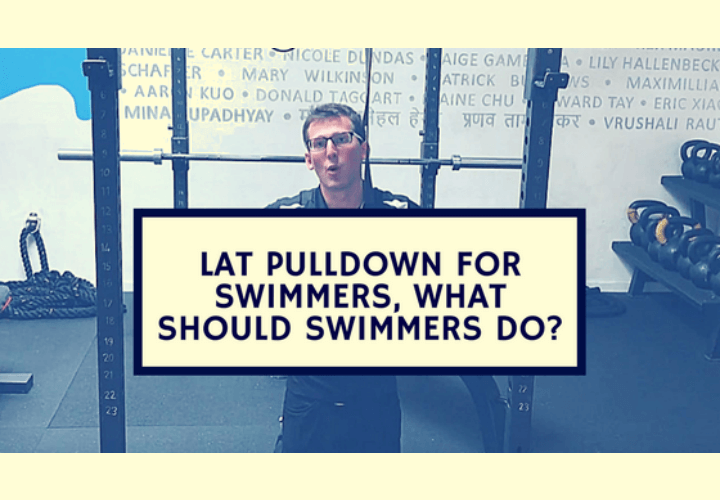Lat Pulldown for Swimmers: What Should Swimmers Do?

By Dr. G. John Mullen, DPT, CSCS – President COR – Sports Training and Physical Therapy.
Most swimmers have performed lat pulldown exercises. Many will do the lat pulldown with a wide grip, but is the wide grip the best position? Does it activate the most appropriate muscles for swimmers?
Many of us believe the lat pulldown with a wide grip position is mandatory for lat activation compared to a narrow grip position. What about a narrow grip? A supinated grip? A pronated grip? What the heck is even the difference? [if looking for more information on these positions, check out Swimming Science’s Resources page.
Some of them also assumed it’s a bad idea to do the close-grip version because it supposedly activates your biceps more than the lats. The biceps also attach to the labrum which can become irritated if the biceps are overactivated. Also, many people (mostly old school weight lifters) have done the behind the neck lat pull down. Then the weight lifting community stated the behind the head position can cause neck injuries, even though I’ve never heard of anyone pull behind their head and hurt themselves. This makes it way to the swimming community (at least some of it), as must coaches use a lat pulldown will pull to the chest, with the hands wide.
This has resulted in the epiphany that the lat pull down to the chest is the best way to perform a lat pull down.
But is this the best position for the lat pulldown for swimmers? Luckily, the Journal of Strength and Conditioning Research looked at this specific topic.
The age-old question:
Behind the Neck or Front of the Neck?
The first group of scientists wanted to figure out which of three different types of lat pulldowns worked the lats the best. They recruited 24 men in their mid-twenties to test three different types of lat pulldowns: behind the neck pulldowns, pulldowns to the chest, and pulldowns using a V-shaped bar.
The scientists attached electrodes to test subjects’ upper back muscles, their chest muscles, their shoulder muscles, and their biceps and had them perform the three varieties of pulldowns using 80% of the weight with which they could do 1 rep (their 1RM).
It turns out that the three actions….
activated the lats equally!
The behind-the-neck version did, however, activate more posterior deltoid and more pec, while the to-the-chest version isolated the pecs more (I’ve chosen to ignore the results of the extreme V-shaped bar because they’re pretty rare for the swimming community).
The top of the chest version, however, was deemed the best choice because the behind-the-neck version didn’t isolate the upper back muscles quite as well. They also assumed, like everyone else, that the top of the chest version was safer, even though they didn’t provide any evidence.
Close Grip or Wide Grip?
The second group of scientists recruited 12 men between the ages of 19 and 30 and attached electrodes to their biceps, lats, and traps. Then they had them perform four different types of pulldowns using 70% of their 1RM:
- Hands wide apart using a supinated grip (palms facing the body)
- Hands wide apart using a pronated grip (palms facing away from the body)
- Hands shoulder-width apart using a supinated grip
- Hands shoulder-width apart using a pronated grip
The attached electrodes told the researchers that shoulder-width and wide-grip versions activated the lats equally, while the varying grips had no significant effect on the biceps or traps.
What did matter, though, was using a pronated grip. Grasping the bar with your palms away activated the lats far better than a supinated grip.
What This Means To You
To effectively target the lats during a pulldown, do the following:
- Use a pronated (palms away) grip.
- Pull to the top of the chest.
- Use the grip (shoulder width or wider) that feels the most comfortable.
Keep in mind, this wasn’t done at 100% maximum intensities (70 – 80% of one’s maximum) and it wasn’t done in women.
Luckily, most weight lifters and those in the swimming community have been using this grip for a while, but now research backs up most of it
If looking for more tips on dryland, look no further than Dryland for Swimmers.
References:
- Lusk SJ, Hale BD, Russell DM. “Grip width and forearm orientation effects on muscle activity during the lat pull-down.” J Strength Cond Res. 2010 Jul;24(7):1895-900.
- Sperandei, Sandro; Barros, Marcos A; Silveira-Jœnior, Paulo C; Oliveira, Carlos G. “Electromyographic Analysis of Three Different Types of Lat Pull-Down.”
- Journal of Strength & Conditioning Research, October 2009, Volume 23, Issue 7, pp 2033-2038.
All commentaries are the opinion of the author and do not necessarily reflect the views of Swimming World Magazine nor its staff. All swimming and dryland training and instruction should be performed under the supervision of a qualified coach or instructor, and in circumstances that ensure the safety of participants.





ace
Here, take my like